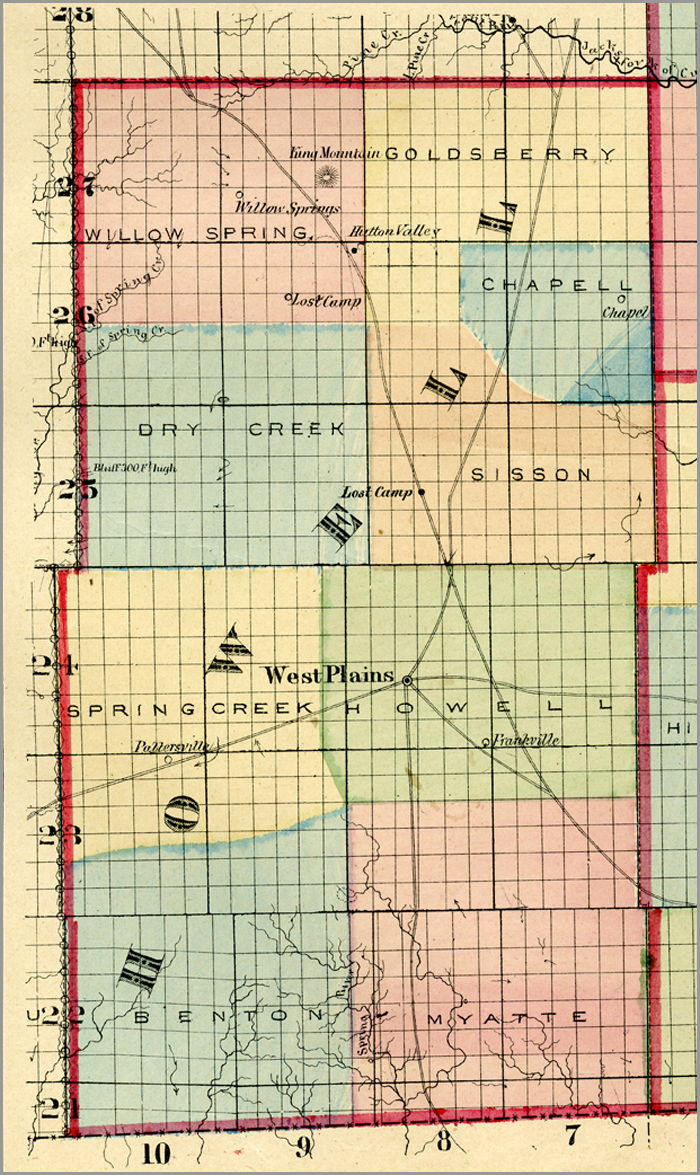Howell County, Missouri

- Formed: March 2, 1857
- County Population 1860: 3,133
- Slave Population 1860: 36
- Civil War Engagements
-Suffered constant guerrilla warfare
Image courtesy of Wilson’s Creek National Battlefield
Traditionally an area inhabited by Native American, principally Osage, the first white settlement in Howell County, Missouri took place in 1832 by James Howell, who settled near present-day West Plains. As the area he settled continued to grow over subsequent years, it was named Howell Valley. Early settlers’ farmed, collected wild honey, traded furs, and hunted wild game. Several businesses became prosperous, including a flour mill and a wool mill.
Howell County is located on the Missouri-Arkansas border. It contains natural fresh water, including the Eleven Point, Plateau, Current, and Gasconade Rivers. The soil is conducive to growing grains, fruits such as peaches and grapes, cotton, and tobacco. The area also has iron and zinc deposits numerous enough for development. Pine forests covered much of the county at the time of settlement, creating a good hunting environment that drew early settlers.
Howell County was organized on March 2, 1857, from parts of Oregon and Ozark Counties. It was named after James Howell, the early settler. The county seat is located at Howell Valley, the name of which was changed to West Plains. Howell was a growing community having 3,133 residents in 1860 and a slave population of 36 individuals. The county was still very young when the Civil War began. Because of its location on the Arkansas border, Howell County residents were predominantly pro-Confederacy. In July, 1861, Brigadier General James Haggin McBride held a recruitment meeting in Howell County. He declared martial law, and commanded all Union supporters to either join the Confederate army or flee, many citizens chose the latter. There were many Union supporters, however, who fought in the Confederate army because of McBride’s promises to protect their homes and loved ones. Men who openly spoke out against the Confederacy, including constable William Monks, were arrested.
There were no major battles in Howell County, though a federal fort established in West Plains caused many small conflicts. Guerrilla and border warfare was constant. Most Union women and children fled, along with other residents. Estimates show that there were probably less than 300 people left in the county at the end of the war. Most of the towns, including West Plains and the County courthouse, were burned during the war. After the war, railroad construction brought about an industrial boom. An ice plant, distillery, brick yard, cigar factory, and canning factory all became very successful.
 Browse all collections in Howell County
Browse all collections in Howell County
-
Consulted:
- Collen Morse Elliott and Lois Mashburn Ott, A Reminiscent History of the Ozark Region (Greenville, SC: Southern Historical Press, Inc., 1995).
- Walter William, The State of Missouri: An Autobiography (Columbia, MO: Press of E.W. Stephens, 1904).
- Arthur Paul Moser, Directory of Towns, Villages, and Hamlets in Missouri, Vol. 3 (Springfield, MO: Ozark Genealogical Society, September 1973).
- http://thelibrary.org/lochist/moser/howellco.html
- http://www.sos.mo.gov/archives/history/counties.asp
- http://geneaologytrails.com/mo/howell












